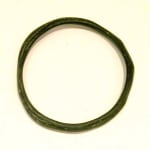Roman Glass Child's Bangle, 100 CE - 300 CE
Glass
2
GF.0196
Centuries ago, mankind learned to shape and mold glass into works of delicate beauty. Transparent or opaque, simple or ornate, richly colored or somber in hue, glass was prized as...
Centuries ago, mankind learned to shape and mold glass into works of delicate beauty. Transparent or opaque, simple or ornate, richly colored or somber in hue, glass was prized as an ornament by queen and commoner alike. The Romans especially enjoyed wearing glass jewelry of elegant shape and in colors that imitated rare and precious gems like lapis, turquoise, agate or onyx. As is still comon today in the Mediterranean, children wore jewelry that echoed the fashions of adults. Imagine this pretty bracelet upon the slender wrist of a child in the classical age. We can hear the child's laugh, ehcoed by the jangle of her bracelets. From such a clue as this we can imagine a vanished life, an entire world.



